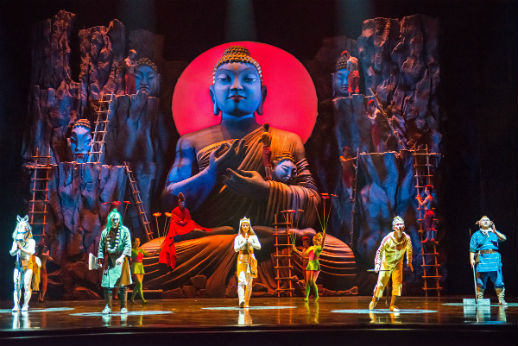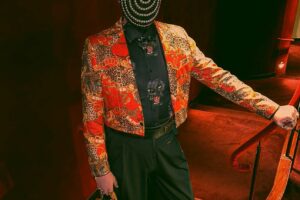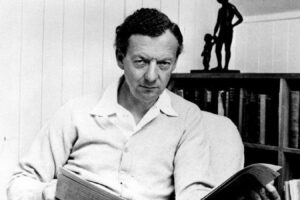

The Lincoln Center Festival has been not just a spy glass but an engine in the kaleidoscoping of once-separate cultures, introducing manglings and mixtures to the New York audience (if there can be one New York audience), and to each other as well. To the opera lover, there is much to regret: We never seem to get Pfitzner’s Palestrina or Mozart’s Il Re Pastore at the festival any more. But the more adventurous types come here to glimpse matters. They never know what they’re going to get.
I went to Monkey: Journey to the West in the expectation of seeing, well, an opera. I misunderstood the brochure. The subject was a few of the interconnected legends that disport around Monkey King, one of the most beloved figures of Southeast Asian myth, literature, art and theater.
I was expecting grandiose costumes and curious movements and a certain amount of low comedy—and they were present, in spades. I was not expecting the zany animations, the martial arts ballets in mid-air, the stage manifestations of passage through and within a dozen gaudy worlds and mystical states, yet these appeared, in full color and light. I was hoping for an interesting Asian-flavored score, melodies hard to crack, rhythms more important than harmonies.
In the event, I was reminded of The Lion King and also of Julie Taymor’s Juan Darien, Magic Flute and The Green Bird. (Taymor studied theater arts in various parts of Asia, I believe.) I was also put in mind of Rimsky-Korsakov’s Sadko, of Glinka’s Ruslan and Ludmila, of Meredith Monk’s opera Atlas, of Monteverdi’s Il Ritorno di Ulisse in the production brought to New York by Les Arts Florissants.
I was reminded of The First Emperor at the Met and of Tea at the City Opera. I was reminded of a number of Japanese fairy-tale films, and of Kurosawa’s Hidden Fortress, the model for Star Wars. I was reminded of Broadway musicals like Lute Song and Pacific Overtures. I was reminded of Fred Astaire dancing the Limehouse Blues and Maria Kowroski dancing The Firebird and Olga Tchickaboumskaya dancing The Dying Swan. I was reminded of Olympic gymnasts, especially during the curtain calls, a series of mid-air body-twisting solo turns.
I was reminded of several Jackie Chan and Quentin Tarantino films, especially the moment in Pulp Fiction when Bruce Willis, seeking revenge against the men who have imprisoned and humiliated him, takes a weapon on the wall … and then sees a Samurai sword, and goes for that instead. We were all with him. Audiences throughout the world recognized (even in a sordid L.A. basement) the weapon of Honor.
I thought then, Don’t the Knights of the Round Table (happily mythical) rate a reputation for legendary Honor any more? Or have they just become too hokey? Lost, beyond redemption, in the swamps of Spamalot? Madame Butterfly’s seppuku strikes us as a deed of honor in disgrace, for however unworthy an object. Guenevere’s near-execution in Camelot just seems the best solution to an intolerable triangle. The Japanese may have lost at Guadalcanal, but they won at Cobweb Castle and Rashomon Gate. We, in the arid, secular West, can still believe in the East.
The “concept,” text and direction of Monkey: Journey to the West are attributed to Chen Shi-Zheng, and I can think of many operas I’d like him to take a whack at: Sadko and Love for Three Oranges and Midsummer Night’s Dream and Mefistofele and Alcina and Tannhäuser, perhaps Jerome Moross’ The Golden Apple. Fairy tales and worlds of many layers seem to be his specialty.

Monkey is assigned his Quest: To assist Tripitaka, an apprentice Bodhisattva, to bring back a bunch of sacred sutras from the West. (You’d think they’d all be on line by now.) They acquire loyal but clumsy companions and set off for the Emerald City of Oz… No. With Monkey’s fearless aid (annoying as he is), they defy skeletons who hope to eat Tripitaka. They defeat a stage-high band of aerial spiders. They combat Princess Iron Fan in order to win her help to cross a volcano. They defeat Captain Hook in order to return the Lost Boys … No.
In the source, a Chinese novel published in 1592, there are 81 trials in all, but the running time is 90 minutes, so a few are omitted here. In the end, Monkey and his Companions defeat the Suitors in order to rescue Penelope … No. The Companions attain Enlightenment, and a four-story Buddha, advised by the compassionate Bodhisattva Guan Yin, assigns them new incarnations about the celestial court. The episode of the Scouring of the Shire and Frodo’s departure is omitted… No.
All quests are alike; it’s what you do with them that makes the difference.
The tale is simple, the execution extraordinary, the sound and light and preposterous martial-arts-ballet of the characters beguiling though the ground choreography can be clumsy. There isn’t much singing, and what there is is excessively amplified: Nonetheless, Huo Yuanyuan brings a full, pleasing soprano to Guan Yin. Wang Lu, who portrayed Monkey in last Tuesday’s performance, is an extraordinary acrobat, mime, baton twirler (but it’s his magic spear), graduate of the Three Stooges academy of martial arts and restrained comedy, and almost the only thing he doesn’t do is sing.
My objection to the production was Damon Albarn’s score, which is surpassingly mediocre, nodding but faintly in the direction of traditional Oriental musics (such as the gamelan orchestras of Indonesia) and such Western figures as Philip Glass. In aspiring to create a pleasant synthesis and avoid “stretching our ears.” Albarn falls between the many possible stools.
When melody is called for, he goes for a dishwater Asiatic pop sound, like the annoying tunes that accompany Las Vegas-style routines (direct from Shanhai or Taipei) that play on the screens in restaurants on Mott Street. Inoffensive is the best he can aspire to. A small band playing everything from electric bass, pipa, French horn and musical saw, have very little of interest to add to the proceedings. Rather than force us to become accustomed to something genuine, Albarn has created fusion kitsch, so anodyne as not even to be irritating: It can be, should be, ignored.
Photos: © Stephanie Berger


























Comments